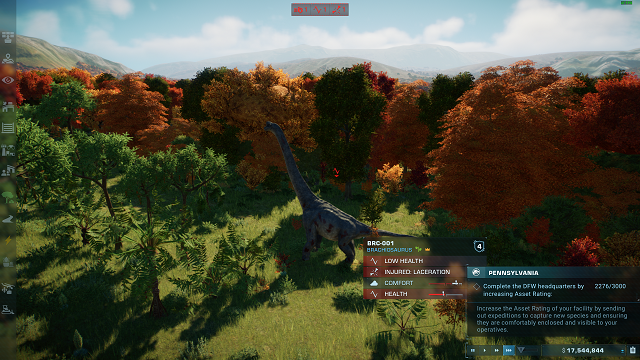No matter how well you take of dinos in Jurassic World Evolution 2, bad things will happen to them eventually. They’ll get sick or hurt, and you’ll have to heal them or place them in quarantine. Some will need injuries treated, while others will need to be put in quarantine.
But how do you heal and quarantine dinosaurs in JWE 2? The process is actually pretty straightforward, even if you may have to do it more than you’d like.
What Ails Ya’? Diagnosing Disease and Injury
There are all types of things that can affect the health of dinos in Jurassic World Evolution 2. They can catch diseases like the common cold, tuberculosis, and rabies. They can also sustain injuries like broken bones from fighting or being attacked. A major fracture, laceration, or second degree burn needs attention, as does a swallowed phone or object.
These ailments can eventually kill the animals in your park, and you’ll need to heal the dinosaurs before they die.

When a dino is injured or sick in Jurassic World Evolution 2, a red notification will pop up at the top of the screen. You can click it to teleport to the dinosaur anywhere in your park; you can also choose the map from the toolbar on the left side of the screen to get an overview of your park, with injured and sick animals highlighted in red.
Further, a red box will appear over the afflicted dino indicating either injury or sickness you’ll need to heal:
- A cross means there’s an injury or swallowed object.
- A virus icon means there’s disease of some sort.
- A heart monitor line means the dino is very low on health.
To be clear, a broken bone icon means there’s literally a broken bone or a laceration that needs healing; some can be healed in the field, while others cannot be. There are myriad icons for other ailments, such as concussions and various pathogens like hookworms.
Healing Dinosaurs in Jurassic World Evolution 2
First, you should build a Response Facility for $100,000. This gives you access to Ranger Teams and Capture Team helicopters. These are used to check the welfare of your dinosaurs and tranquilize them if they need treatment — or you want to sell them.
To keep track of dino health or diagnose injuries, build a Ranger Post in each enclosure and assign a Ranger Team to it. You could do this manually, but it’s cumbersome when your park starts growing.
To heal dinosaurs, you’ll want to then build a Paleo-Medical Facility as soon as you can for $250,000. This gives you access to the Mobile Vet Unit, which can diagnose ailments throughout your park.
You can add a second Ranger Team and MVU by researching the Additional Vehicles upgrade in the Infrastructure node.
While you may know the general nature of what’s wrong, you won’t know exactly what’s wrong with a dinosaur until you inspect it with a Mobile Vet Unit. When a dinosaur has an ailment:
- Select the Mobile Vet Unit
- Select Add Task
- Select the dinosaur
The MVU will go to the enclosure and diagnose the dinosaur. For minor ailments, the MVU can heal animals in the field. This includes giving shots for lung diseases (the common cold, though, can’t be treated and heals on its own). For major injuries, you’ll have to transport the specimen to the Paleo-Medical Facility.

To transport a dinosaur to the Paleo-Medical Facility:
- Tranquilize it with a Capture Team from a Response Facility.
- Choose the Transport option in the toolbar, just as you would for transporting animals to and from enclosures.
- Click the helipad at the Paleo-Medical Facility
Bear in mind that you also must have the scientists and staff available to perform the healing process. If any are performing other tasks like research or on expeditions, you’ll have to wait until they’re done or hire more scientists. Some dinos also require scientists with high welfare values to heal, represented by the number under or next to the cross icon for each scientist.
Sometimes it will take more than one staff member to perform a function, just as it may for incubation, research, or to carry out an expedition. If you assign a scientist or set of scientists that have more than the value needed, the operation’s duration will decrease.
To return a dino to its enclosure after being treated at the Paleo-Medical Facility, select the Paleo Facility and select transport underneath the picture of the animal. Then select the enclosure you want it to be returned to.
Lastly, it’s worth noting that all dinosaurs can heal at 0.23% HP/s, so if a sickness or injury isn’t too severe, they can heal themselves back to full health, which I’ve had happen with a Velociraptor.
How to Quarantine Dinos
Dinosaurs will sometimes contract diseases that you can’t treat right away. Instead, you’ll have to research treatments for them, and the research requirements ask you to quarantine dinosaurs for a specific amount of time.
To quarantine dinosaurs, build small enclosures away from your other pens. Tranquilize the sick animals, and transport them to the smaller enclosures.
Certain research, such as that for the Avian Pox dart, requires keeping all infected dinosaurs quarantined for 15 seconds. The timer does not seem to count down, so just keep them separated until the requirement is met.
No matter the ailment, you now know how to heal dinosaurs in Jurassic World Evolution 2. No disease or injury will stop you now. Well … maybe. If a dinosaur does die, you’ll need to remove it or sickness could spread! For more tips, head over to our JWE 2 guides hub.







Published: Nov 13, 2021 11:05 am